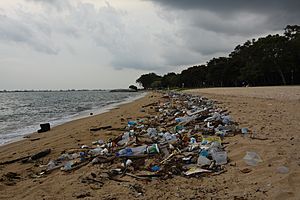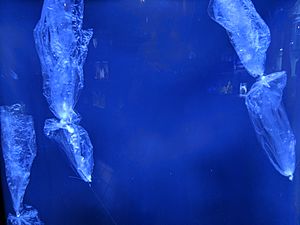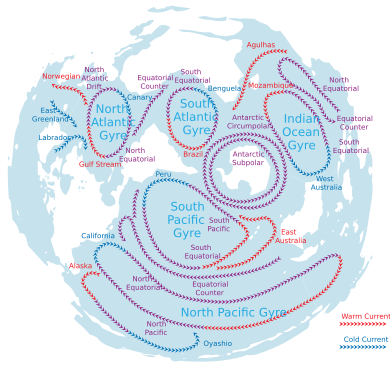Garbage patch facts for kids
A garbage patch is a huge area in the ocean where plastic and other trash from human activities collect. These patches form when ocean currents and winds push the trash together in spots where the water moves slowly. They are a big problem because they fill the oceans with harmful chemicals, hurt sea animals, and even add to greenhouse gas emissions that warm our planet.
The United Nations Environment Programme once estimated that for every square mile of ocean, there are about 46,000 pieces of plastic. Most of this plastic pollution comes from rivers in countries like China, Indonesia, the Philippines, and Vietnam. These rivers carry about 90% of all the plastic that reaches the world's oceans.
Contents
Where Are Ocean Garbage Patches Found?
By 2014, scientists had found five main areas in the oceans where most plastic gathers. Researchers collected many samples from around the world to find these "hot spots" of plastic pollution on the ocean's surface. The way the plastic was spread out matched how ocean currents move.
The biggest and most well-known is the Great Pacific garbage patch. It is located in the North Pacific Ocean. The other four main garbage patches are:
- The North Atlantic garbage patch, found between North America and Africa.
- The South Atlantic garbage patch, located between South America and Africa.
- The South Pacific garbage patch, found west of South America.
- The Indian Ocean garbage patch, located east of South Africa.
The Great Pacific Garbage Patch
The Great Pacific Garbage Patch is a huge area in the central Pacific Ocean where lots of marine debris (trash in the ocean) gathers. It's often called the Pacific Trash Vortex. This patch is not a solid island of garbage. Instead, it's a swirling area of tiny plastic pieces and other floating trash.
This trash comes from countries all around the Pacific Ocean. This includes places in Asia, North America, and South America. Most of the garbage is made of very small pieces of plastic, often smaller than a fingernail. These tiny pieces are called microplastics. They float just below the surface of the water. This is why you can't see the patch from satellites or even from a boat.
Scientists have estimated that the patch covers about 1.6 million square kilometers. That's about twice the size of Texas! Most of the plastic in the patch (about 92%) is made up of larger items. These items haven't broken down into microplastics yet. Some of the plastic is over 50 years old. It includes things like plastic lighters, toothbrushes, water bottles, and plastic bags.
The amount of trash in the patch is growing quickly. It is believed to have increased ten times every ten years since 1945. For every pound of tiny ocean creatures called plankton, there are about six pounds of plastic. There's also a similar patch in the Atlantic Ocean called the North Atlantic garbage patch. This growing problem harms ocean animals and their homes.The South Pacific Garbage Patch
The South Pacific garbage patch is a huge area in the Pacific Ocean where lots of plastic trash and tiny plastic pieces float around. It's found in a part of the ocean called the South Pacific Gyre. This gyre stretches from east of Australia all the way to South America. It goes as far north as the Equator and south to the Antarctic Circumpolar Current.
When plastics break down in the ocean, they can release harmful chemicals. Scientists confirmed this garbage patch in mid-2017. It's like the Great Pacific garbage patch was ten years ago. You can't see the South Pacific garbage patch from satellites because most of the plastic pieces are smaller than a grain of rice.The Indian Ocean Garbage Patch
The Indian Ocean garbage patch is a huge area in the central Indian Ocean where lots of plastic waste and other trash collects. It was found in 2010. This patch is part of the Indian Ocean Gyre, which is like a giant swirling current of water. There are five main ocean gyres around the world, and each one can collect trash.
Imagine it not as a solid island of trash, but more like a 'plastic soup.' The plastic breaks down into tiny pieces, so small you can't even see them without special tools. These tiny plastic bits, along with some chemicals, float in the water. Scientists estimate there can be about 10,000 tiny plastic pieces in just one square kilometer of water!The North Atlantic Garbage Patch
The North Atlantic garbage patch is a huge area in the Atlantic Ocean where lots of human-made trash floats. It's a type of garbage patch made of marine debris, which means rubbish found in the sea. This patch was first noticed in 1972. It floats inside a giant ocean current system called the North Atlantic Gyre.
Scientists from the Sea Education Association studied this patch for 22 years. They believe it is hundreds of kilometers wide. It can have over 200,000 pieces of trash in just one square kilometer. Most of this trash comes from human waste that travels from rivers into the ocean. It is mainly made up of tiny plastic pieces called microplastics.
This garbage patch is very dangerous for ocean animals and even for humans. Animals can eat the plastic or get tangled in it. Not many groups have worked to clean up the North Atlantic garbage patch. Most efforts have focused on the Great Pacific garbage patch, which is a similar area in the Pacific Ocean.How Plastic Harms the Ocean
How Plastics Break Down

Scientists have studied how plastic breaks down in places like the North Atlantic patch. Unlike natural materials that rot away, plastic just breaks into smaller and smaller pieces. This process is called photodegradation. The plastic stays plastic, even as it gets tiny. It can break down to a molecular level.
Some plastics break apart within a year of entering the water. When they do, they release harmful chemicals. These can include substances like bisphenol A, PCBs, and parts of polystyrene. As plastic breaks down, it floats near the surface of the ocean. The pieces become so small that tiny sea creatures can eat them. This means the plastic enters the food chain. Also, plastic exposed to sunlight in water can create greenhouse gases, which adds to climate change.
Danger to Marine Animals
The 2017 United Nations Ocean Conference warned that by 2050, there might be more plastic in the oceans than fish by weight. Many long-lasting plastics end up in the stomachs of sea animals. Birds and fish are often attracted to plastic. When marine life eats plastic, it enters the food chain. This can cause bigger problems when larger animals eat the smaller ones that have already eaten plastic.
Animals can also get tangled in plastic nets and rings. This can lead to their death. Plastic pollution affects at least 700 types of sea creatures. These include sea turtles, seals, seabirds, fish, whales, and dolphins. Whales have been seen in the Great Pacific garbage patch. This puts them at risk of getting tangled or eating plastic as they travel or live there.
Eating Plastic

With so much plastic in the ocean, living things are more likely to be harmed by eating it or getting tangled. About 23% of sea mammals and 36% of seabirds have been hurt by plastic in the ocean. A lot of the trash, maybe 70%, is thought to be on the ocean floor. Microplastics are only tiny, a few millimeters wide. This means sea life at almost every level of the food chain is affected.
Animals that feed on the ocean bottom can accidentally swallow microplastics while looking for food. Smaller sea creatures like mussels and worms sometimes mistake plastic for their prey. Larger animals also eat plastic indirectly. They eat fish that have already eaten microplastics. Humans are also at risk of eating microplastics. People who eat seafood might also eat some of the microplastics that were inside the marine life. Oysters and clams are common ways humans consume microplastics. Studies show that 36% of seabirds eat plastic because they think bigger pieces are food. Plastic can block an animal's insides or tear its stomach lining. This can cause starvation and death.
Getting Tangled
Not all sea animals are affected by eating plastic. Some get tangled in larger pieces of trash. This can be just as harmful as the tiny microplastics. Trash that wraps around an animal can cause it to choke or drown. If the trash gets stuck around a limb, that limb might grow in a strange way. The problem of plastic in the ocean becomes a cycle. Animals killed by plastic eventually break down in the ocean, releasing the plastics back into the environment.
Plastic on Land
In 2017, scientists found the highest amount of plastic trash anywhere in the world on Henderson Island. This island in the South Pacific is remote and has no people living on it. The trash got there because of the South Pacific Gyre (a large ocean current). The beaches had an estimated 37.7 million pieces of trash, weighing 17.6 tonnes. On one part of North Beach, between 17 and 268 new items washed up every day on a 10-meter section.


